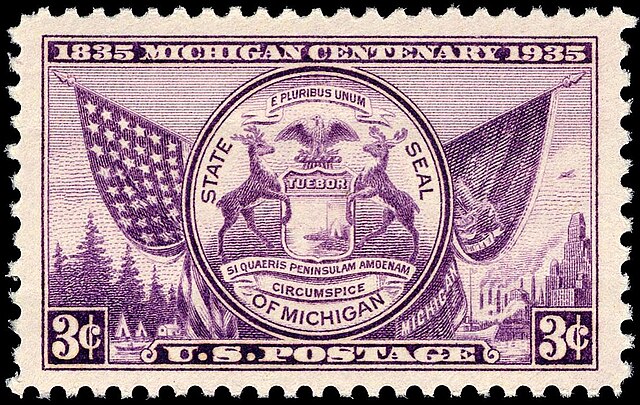The Straits of Mackinac are the short waterways between the U.S. state of Michigan's Upper and Lower Peninsulas, traversed by the Mackinac Bridge. The main strait is 3+1⁄2 miles wide with a maximum depth of 295 feet, and connects the Great Lakes of Lake Michigan and Lake Huron. Given the large size and configuration of the straits, hydrologically, the two connected lakes are one body of water, studied as Lake Michigan–Huron. Historically, the native Odawa people called the region around the Straits Michilimackinac.
Overhead view of the Straits of Mackinac linking Lakes Michigan (left) and Huron (right)
Satellite photograph of icebreaker paths through the ice in the straits. The Mackinac Bridge is the vertical line in the center, connecting the landmass of the Upper Peninsula above to lower Michigan below. The icebreaker paths run right-to-left, connecting the open water of Lake Michigan with the open water of Lake Huron between Mackinac Island and Round Island.
The Straits of Mackinac, spanned by the Mackinac Bridge, seen from the southern shore.
Mackinac Bridge from Mackinaw City
Michigan is a state in the Great Lakes region of the Upper Midwest region of the United States. It borders Wisconsin to the northwest in the Upper Peninsula, and Indiana and Ohio to the south in the Lower Peninsula; it is also connected by Lakes Superior, Michigan, Huron, and Erie to Minnesota and Illinois, and the Canadian province of Ontario. With a population of nearly 10.12 million and an area of 96,716 sq mi (250,490 km2), Michigan is the 10th-largest state by population, the 11th-largest by area, and the largest by area east of the Mississippi River. Its capital is Lansing, and its largest city is Detroit. Metro Detroit is among the nation's most populous and largest metropolitan economies. The name derives from a gallicized variant of the original Ojibwe word ᒥᓯᑲᒥ, meaning "large water" or "large lake".
Père Marquette and the Indians (1869), by Wilhelm Lamprecht
Treaty of Paris, by Benjamin West (1783), an unfinished painting of the American diplomatic negotiators of the Treaty of Paris which brought official conclusion to the Revolutionary War and gave possession of Michigan and other territory to the new United States
Commemorative stamp, issue of 1935, celebrating the 100th anniversary of Michigan statehood.
Detroit in the mid-twentieth century. At the time, the city was the fourth-largest U.S. metropolis by population, and held about one-third of the state's population.








